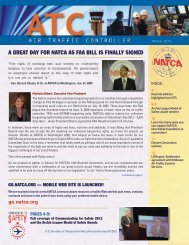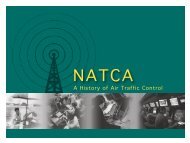Against the Wind - National Air Traffic Controllers Association
Against the Wind - National Air Traffic Controllers Association
Against the Wind - National Air Traffic Controllers Association
Create successful ePaper yourself
Turn your PDF publications into a flip-book with our unique Google optimized e-Paper software.
222<br />
<strong>Against</strong> <strong>the</strong> <strong>Wind</strong><br />
<strong>National</strong> Archives<br />
Privatized ATC: Four airlines operated this first <strong>Air</strong>way <strong>Traffic</strong> Control Unit at Newark <strong>Air</strong>port—plus o<strong>the</strong>rs in Chicago,<br />
Cleveland, Pittsburgh, and Oakland—for seven months before <strong>the</strong> Bureau of <strong>Air</strong> Commerce took over in July 1936.<br />
2000<br />
26<br />
Oct.<br />
not afford to carry out its mission. Accordingly, <strong>the</strong><br />
Commerce Department asked <strong>the</strong> airlines to run <strong>the</strong><br />
system until it could take over. American, Eastern,<br />
TWA, and United opened <strong>the</strong> first <strong>Air</strong>way <strong>Traffic</strong> Control<br />
Unit at Newark <strong>Air</strong>port on December 1, 1935.<br />
The FLRA certifies NATCA as <strong>the</strong> exclusive bargaining representative for<br />
22 controllers in <strong>the</strong> Hawaii <strong>Air</strong> Guard and Defense Department on <strong>the</strong><br />
islands. This is <strong>the</strong> eleventh and last new bargaining unit organized by <strong>the</strong><br />
Soon after, <strong>the</strong> four airlines launched facilities<br />
in Chicago, Cleveland, Pittsburgh, and Oakland,<br />
California. Dressed in white shirts and ties, controllers<br />
received position reports from airline dispatchers<br />
and pushed brass shrimp boats tagged with information<br />
about each flight across aeronautical charts to<br />
monitor <strong>the</strong>ir progress. They issued clearances by<br />
telephone to <strong>the</strong> dispatchers, who relayed <strong>the</strong>m to<br />
pilots via primitive radios.<br />
By mid-1936, <strong>the</strong> Commerce Department was<br />
flush enough to acquire <strong>the</strong> operations and staff <strong>the</strong>m<br />
with federally certified controllers. Many of <strong>the</strong> airline<br />
employees joined <strong>the</strong> Bureau of <strong>Air</strong> Commerce so<br />
<strong>the</strong>y could continue working at <strong>the</strong> renamed <strong>Air</strong>way<br />
<strong>Traffic</strong> Control Stations.<br />
Except for some very small, municipally<br />
owned towers run by private firms, air traffic control<br />
remained within <strong>the</strong> province of <strong>the</strong> federal government<br />
for nearly half a century.<br />
In <strong>the</strong> wake of <strong>the</strong> 1981 strike, a hamstrung<br />
FAA turned to <strong>the</strong> private sector once more. Scrambling<br />
to keep <strong>the</strong> system running with just one-quarter<br />
of its controller work force, <strong>the</strong> agency closed<br />
eighty small facilities known as Level I VFR towers.<br />
Two-thirds of <strong>the</strong> towers were reopened by <strong>the</strong> fall of<br />
1984, including nine operated by private companies<br />
under contract with <strong>the</strong> FAA. The towers ranged<br />
from North Myrtle Beach in South Carolina to Laredo,<br />
Texas, to Pendleton, Oregon.<br />
union during <strong>the</strong> calendar year. NATCA now represents 15,000 controllers,<br />
80 percent of whom are union members, and nearly 4,000 o<strong>the</strong>r FAA<br />
employees, whose membership percentage varies.




